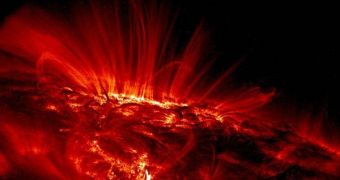Astronomers at NASA now bless their inspiration of sending the STEREO twin solar observatories into space, as the two spacecraft revealed only a few days ago the fact that the Sun seemed to be resuming its normal activity for this time. Last year, the star should have reached its minimum peak, and then begun to act up again, as part of its regular, 11-year cycle. But that didn't happen, and scientists were worried at the lack of activity they were seeing. Now, STEREO has beamed back images of the largest sunspot recorded in the last 18 months, taken on the backside of the star.
Experts were most concerned about the Sun earlier this year, when predictions showed that a period of intense activity would follow. However, that didn't happen, so they started looking for clues of why that occurred. Then, a bit unexpectedly, the star seemed to have resumed “normal operations.” “This is the biggest event we’ve seen in a year or so. Does this mean we’re finished with the minimum or not? It’s hard to say. This could be it. It’s got us all excited,” NASA Goddard Space Flight Center Heliophysics Division research scientist Michael Kaiser shared, as quoted by Wired.
The spot that STEREO picked up will only come into view on May 8th, when the Sun will be kind enough to show that face to us. Solar observatories around the planet are already pointing their telescopes to the star, hoping that the spot will not disappear in two days. The Goddard researcher said that, “We have seen a few events in the new cycle, but they’ve all been pretty timid compared to this one. In angular size, this one wasn’t spectacularly big, but it was certainly pretty bright.” In other words, while the Sun may not yet be performing at peak capacity, it's still doing a lot more than a few months ago.
According to Kaiser, this was the longest solar minimum recorded in about 100 years, with reference points dating back over 28 solar cycles, to 1745. The tight connection between the amount of energy Earth gets from the Sun and sunspot intensities has prompted some journalists to investigate links between extended minimum times and the planet's climate. Some have even gone as far as telling that prolonged solar inactivity could cause global cooling, the opposite effect of global warming.

 14 DAY TRIAL //
14 DAY TRIAL //